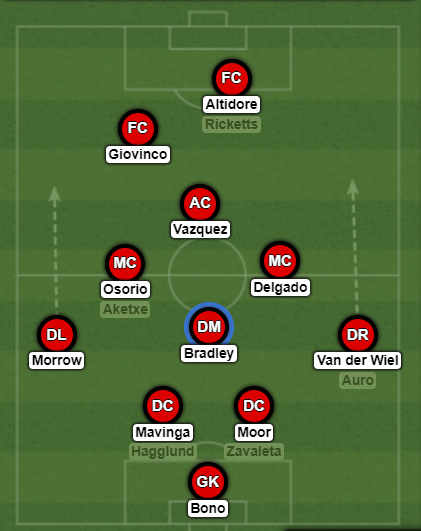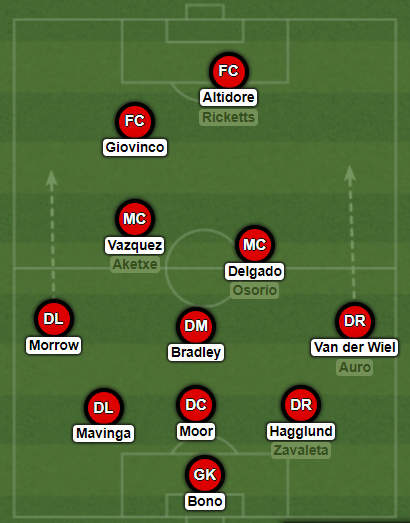Toronto FC 2018 Season Preview
/Here's more about Expected Goals (xG) and Expected Assists (xA). Expected Buildup Goal Chain is abbreviated to xB. Defensive Acts are per 96 minutes and are defined as blocks, interceptions, tackles, and challenges. Touch percentage is the player's percentage of all team touches while on the field. Pretty much all the data in the above graphic can be found in our interactive tables. They're pretty cool so you should check them out.
By Aaron Nielsen (@enbsports)
Toronto was arguably the best team in MLS history last season, on their way to their first Eastern Conference title, their first Supporters' Shield, and their first MLS Cup trophy. They've only added more talent in 2018 so are hoping to do it all again, this time with a CONCACAF Champions League trophy thrown in.
2017 in review
A year ago, I wrote that Toronto FC were favorites to win the 2017 MLS Cup. Off-season signings Chris Mavinga and Victor Vazquez (who signed the day of publishing) helped cement Toronto as the best team in MLS and the Reds didn't disappoint, achieving the MLS record for points in a regular season. Two difficult playoff series wins against NY Red Bulls and Columbus led to Toronto playing Seattle in a 2016 rematch for the MLS Cup. Like the year before, Toronto dominated the game, but this time they took the championship with a 2-0 win.
Though they looked unstoppable for most of the season, Toronto's dominance wasn't as noticeable analytically. They finished eighth in possession, scored 18 goals more than expected (that's even more than Atlanta!), allowed five fewer than expected, and finished 12th in shots attempted. Part of this is due to game state, as Toronto were 19-2-1 when scoring first. Another part is that they had very few close games, with 19 being decided two or more goals. Finally, and most obviously, Toronto just has exceptional attacking talent that is capable of scoring goals from difficult spots.
Offseason Changes
As one would expect from the returning champions, Toronto didn't make many moves in the off-season. Steven Beitashour, Benoit Cheyrou, Armando Cooper and Raheem Edwards played a role in Toronto FC's success, although their replacements look comparable or even better. Dutch International Gregory van der Wiel, Spanish midfielder Ager Aketxe and Brazilian Auro are all solid additions, and they've signed academy prospects Ayo Akinola and Liam Fraser to senior contracts. The biggest move in the off-season might be a change of tactics, with Toronto leaving their 5-3-2 formation which brought them success in favor of a 4-1-2-1-2 diamond. That and Toronto's success in the CONCACAF Champions League might be the two main stories leading to what is expected to be another MLS Cup run.
Positional Expectations
Defense
In 2016, Toronto FC started playing the 5-3-2 formation because of Beitashour and Justin Morrow's attacking abilities from the wings, coupled with a lack of senior center backs behind Drew Moor. Both Nick Hagglund and Eriq Zavaleta were adequate in their roles, but the signing of Mavinga has made it less necessary to play five at the back. Toronto also has greater confidence in Goalkeeper Alex Bono, who covers a lot more space quickly in his own box than now-backup Clint Irwin. Toronto may still return to the 5-3-2 formation, especially playing against sides with athletic strikers or if they wish to give Morrow and van der Wiel more attacking freedom. During his most successful days in Europe, van der Wiel touched the ball almost 60 times per game, with his offensive numbers being more comparable to a midfielder than a defender. His ability and versatility could see him play in the midfield with Nicolas Hasler or in front of Auro at right back.
Midfield
If I was going to identify the moment when Toronto became a good team in the league, it would not be the signing of Sebastian Giovinco. When Michael Bradley started playing the role of defensive midfielder, this team found it's final form. With one of the best engines in the game, Bradley plays an important role in both helping the defense and setting up the offense. That unheralded offensive contribution is shown by his 10.09 xBuildup GC, which means he was involved the 2nd most goals in MLS where he did not make the final pass or take the final shot.
Despite Bradley's effort, it could be argued that Toronto lacked some strength in the midfield. The club could use more contributions from Marky Delgado and Jonathan Osorio, who combined for only five goals and three assists in close to 4000 minutes. Like Bradley, Vazquez played a multiple role as a possession midfielder and as a classic number 10, setting up the forwards and leading the team with 76 key passes, 10 assists and also scoring eight goals. Ager Aketxe, a technical player who is comfortable passing the ball, could replace either Delgado or Osorio in the starting lineup.
Forward
Toronto has Tosaint Ricketts, who scored seven goals last season, and 18 year old Ayo Akinola will be an exciting prospect to follow, but the attack is all about Jozy Altidore and Giovinco. If Toronto is going to repeat as MLS Cup champions and be the first MLS club to win CONCACAF Champions League, they will rely on the goal scoring ability of Giovinco and Altidore. Despite combining for 34 goals and 13 assists including playoffs last year, both players have taken their fair share of criticism. You could argue that Giovinco takes too many shots and Altidore lacks the consistency of a top striker, but my view is both players are world class and with Bradley and Vazquez are the reason why Toronto is the best team in MLS.
Altidore was Toronto FC MVP last season, not only for how effective he was in the playoffs (he scored two winning goals and gave the team additional attacking options) by allowing the club to rely less on Giovinco. Altidore has the ability to get more shots off through his own effort than other center forwards, and has scored 0.81 goals per 96 minutes while converting close to 50% of his shots on target. Altidore has also allowed Giovinco to take on the role of the number one option, while if he were playing on another MLS club he could score many more goals. He took 50 fewer shots than the league's top goal scorers Nikolic and Villa, showing his willingness to defer to his talented teammates.
Which leads us to Giovinco, who again wowed us in 2017 with his ability. His five direct free kick goals got the highlights, but Giovinco did take a bit of criticism in the Toronto media early last season. Most of that came because he was able to defer to players like Vazquez and Altidore, who were happy to share the spotlight. Giovinco now has 55 goals, 37 assists an MVP Award, and MLS Cup ring. Given those accolades, I feel it is fair to include him in the conversation of MLS All Time greats.
2018 Prognosis
Interestingly, many betting outlets have Toronto either equal or behind Atlanta as 2018 MLS Cup favorites. Don't buy it. Toronto only improved this offseason and could challenge their record for most points in a season. Despite a difficult draw, they should also do well in the CONCACAF Champions League. If Toronto are challenged in 2018 it will be a reflection of the overall improved quality of the league, because in my opinion this Toronto FC team is the greatest team in MLS history.



